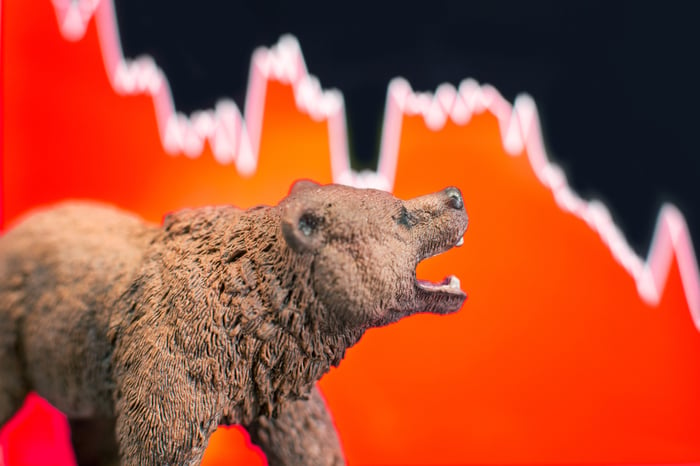Investing on Wall Street has been nothing short of an adventure for the past 16 months. After hitting their respective all-time highs between November 2021 and the first week of January 2022, all three major U.S. stock indexes plummeted into a bear market. The growth-driven Nasdaq Composite (^IXIC 0.27%), which was largely responsible for lifting the broader market to new heights, brought up the rear with a loss of 33% in 2022.
But when there's pain on Wall Street, there's often opportunity, too. Though we'll never be able to predict when corrections and bear markets will begin or how long they'll last, history does show that every sizable decline has eventually been put into the rearview mirror by a bull market. It means the Nasdaq Composite's tumble is a buying opportunity for investors who are planning to use time as an ally.

Image source: Getty Images.
It's also an ideal time to go shopping for the game-changing growth stocks that have been beaten down by the current bear market. What follows are five awe-inspiring growth stocks you'll regret not buying on the Nasdaq bear market dip.
Alphabet
The first innovator that can be scooped up hand over fist during the Nasdaq bear market swoon is Alphabet (GOOGL 0.79%) (GOOG 0.85%), the parent company of search engine Google and popular streaming platform YouTube. Although an increased likelihood of a U.S. recession is hurting Alphabet's ad-reliant business in the near term, this is a company with too many competitive advantages for investors to ignore.
It all starts with internet search engine Google. In April, Google accounted for 92.6% of worldwide search. Further, it's been about eight years since it last commanded less than a 90% share of global search. As the clear go-to for advertisers, Google is going to possess phenomenal ad-pricing power most of the time. As an added note, periods of economic expansion last disproportionately longer than recessions, which bodes well for ad-driven businesses.
While Google is Alphabet's cash-flow pillar, it's what the company is doing with this cash flow that should be raising eyebrows. For instance, Google Cloud has worked its way up to a 10% share of global cloud infrastructure service spending. Enterprise cloud spending is still in its early innings, and Google Cloud generated its first profit in the quarter that ended in March.
Likewise, YouTube is an intriguing source of subscription revenue and ad growth. In the span of about a year, the number of Shorts (short-form videos of 60 seconds or less) viewed daily has catapulted from 30 billion to north of 50 billion.
The cherry on top is that Alphabet is cheaper now than it's ever been as a publicly traded company.
Fiverr International
A second magnificent growth stock you'll regret not adding during the Nasdaq bear market decline is gig economy up-and-comer Fiverr International (FVRR -0.97%). Although recessionary fears could adversely impact the job market in the short run, Fiverr has three key catalysts that help it stand out as a phenomenal long-term buy.
For starters, the labor market has completely changed due to the COVID-19 pandemic. Even though some people have returned to the office, more are working remotely than ever before. This bodes well for Fiverr, which operates a fast-growing online-services marketplace for freelancers.
A second differentiator for Fiverr is how freelancers on its platform present and price their services. Whereas it's common for freelancers using competing marketplaces to price their services at an hourly rate, freelancers on Fiverr list their projects with an all-inclusive price. The advantage of this is unparalleled price transparency. Based on the modest growth in both the number of buyers on Fiverr's platform and spending per buyer, it appears this focus on transparency is working.
And third, Fiverr's take rate -- the percentage of each deal it gets to keep -- blows its competitors out of the water. Fiverr's take rate hit 30.2% during the quarter that ended in December, yet the company continues to grow its freelancer and buyer base. A sustained take rate above 30% should allow Fiverr's operating margin to be head and shoulders above its peers.

Image source: Getty Images.
CrowdStrike Holdings
The third awe-inspiring growth stock you'll be kicking yourself for not buying during the Nasdaq bear market dip is cybersecurity company CrowdStrike Holdings (CRWD -0.42%). Despite trading at a premium valuation, CrowdStrike has macro and company-specific catalysts that make it a surefire buy for patient investors.
In terms of the former, CrowdStrike is benefiting from the evolution of cybersecurity solutions into a basic necessity service. The pandemic served as a kick-in-the-pants reminder for businesses of all sizes how important it is to have an online presence and data that's easily accessible in the cloud. With businesses accelerating this move into the cloud, companies like CrowdStrike are going to remain busy, even if the U.S. economy shifts into reverse.
When it comes to company specifics, CrowdStrike is one of the smartest stocks investors can buy to take advantage of the artificial intelligence (AI) revolution. The company's Falcon security platform is cloud native and relies on AI and machine-learning software to grow more effective at recognizing and responding to threats over time. The company's gross retention rate of 98% clearly shows that CrowdStrike's 23,000-plus customers will pay a premium for the quality of protection they're receiving.
The other indication that CrowdStrike's software-as-a-service (SaaS) solutions are a hit can be seen with add-on sales. A whopping 62% of its clients have purchased five or more cloud-module subscriptions. Six years ago, a high-single-digit percentage of its customers had bought four or more cloud-module subscriptions. These add-on sales are CrowdStrike's golden ticket to eventually hitting an adjusted subscription gross margin of 80% (or higher).
American Eagle Outfitters
A fourth exceptional growth stock that you'll regret not adding to your portfolio during the Nasdaq bear market drop is retailer American Eagle Outfitters (AEO 2.52%). Though retail stocks aren't usually the best place to look for value with a possible recession looming, American Eagle has a lengthy track record of outperformance that starts with its management team.
One of the primary reasons American Eagle Outfitters has excelled for so long is the company's inventory management. Although every retailer will eventually find itself holding products consumers aren't buying, American Eagle has been swift to discount merchandise and clear its shelves for prime-selling clothes and accessories. Not cheapening its brand through excessive discounting while also avoiding pricing consumers out of its products is a delicate tightrope that the company is successfully walking.
Another reason American Eagle Outfitters is a rock-solid buy is the focus it's placed on building up its digital presence. While retail sales are a bit challenged at the moment, the company's fourth-quarter operating results show that consolidated digital sales are up 19% from the fourth quarter of 2019 (i.e., compared to pre-pandemic levels). Convenience is key in the retail space, and American Eagle's management is making investments in all the right places.
Speaking of investing in all the right places, intimate apparel brand Aerie has been a key source of growth for American Eagle Outfitters. After growing annual sales by 39% in 2021, Aerie's annual revenue jumped another 9% in 2022. A modest expansion of the Aerie store base should help American Eagle sustain a double-digit earnings growth rate over the next five years.
The fifth awe-inspiring growth stock you'll regret not buying during the Nasdaq bear market dip is social media stock Pinterest (PINS 1.58%). Even though Pinterest is contending with the same short-term advertising weakness that's adversely impacting Alphabet at the moment, it has well-defined catalysts that should allow it to outperform for years to come.
The first thing that stands out about Pinterest is the long-term growth in its monthly active user (MAU) count. Although its MAUs vacillated wildly during the initial and end stages of the pandemic, the five-year trend for Pinterest's MAUs points decisively higher. As of the end of March, Pinterest stood tall with 463 million MAUs.
Pinterest also has an uncanny ability to monetize its users, regardless of whether its MAU count has been increasing or decreasing over the very short term. Despite a 1% decline in global average revenue per user (ARPU) in the quarter that ended in March, Pinterest logged 10% ARPU growth for full-year 2022. Having 463 million MAUs is proving to be more than enough of a lure to get advertisers to spend their money.
However, the most intriguing aspect of Pinterest's business is its operating model. Most social media platforms are being adversely impacted by changes to data-tracking software from app developers. Comparatively, Pinterest doesn't have to rely on likes or other tools to help merchants target its users. The entire premise of Pinterest's platform is for users to freely post the things, places, and services that interest them. Not only can this important info be served to advertisers on a silver platter, but it opens the door for Pinterest to eventually become a key player in the e-commerce space.





